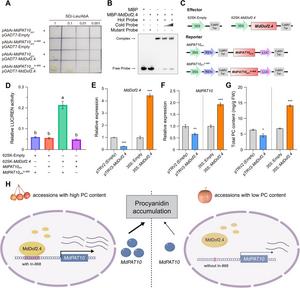Apples rank among the world’s most consumed fruits, admired for their taste and their role as a source of dietary antioxidants. These antioxidants, mainly polyphenols, are key to preventing inflammation and promoting cardiovascular health. However, domestication and selective breeding have tilted the balance toward flavor and appearance, often at the expense of nutritional content. While enzymes and transcription factors driving polyphenol biosynthesis are well known, the influence of post-translational regulation remains elusive. Palmitoylation—a chemical process that modifies protein activity—has recently emerged as a hidden regulator in plants. To close this knowledge gap, scientists set out to uncover how genetic variation and protein modification shape polyphenol production in apples.
In a study (DOI: 10.1093/hr/uhae349) published in Horticulture Research on December 12, 2024 (corrected March 1, 2025), researchers from Northwest A&F University, China, reported a breakthrough in apple nutritional genomics. By analyzing 134 Malus accessions from wild species to modern cultivars, they identified the MdDof2.4–MdPAT10 module as a central regulator of polyphenol accumulation. The transcription factor MdDof2.4 was found to bind to a 51-base-pair insertion in the MdPAT10 promoter, enhancing the gene’s activity and boosting antioxidant levels—a finding that illuminates how ancient alleles lost in breeding can be reclaimed to restore nutritional quality.
The team began by measuring 15 types of polyphenols in apples representing wild species, hybrids, and cultivated varieties. The data revealed a clear nutritional gradient—wild apples contained far higher levels of polyphenols than their domesticated counterparts. Through genome-wide association studies involving nearly 11 million genetic markers, researchers pinpointed MdPAT10, a palmitoyltransferase gene, as tightly linked with procyanidin content. Functional tests showed that overexpressing MdPAT10 in apple calli dramatically increased antioxidant accumulation, while silencing it led to sharp declines.
The mystery deepened when the team identified a 51-bp insertion, termed In-868, in the MdPAT10 promoter. This genetic fragment—present in wild but rare in cultivated apples—created a new binding site for the transcription factor MdDof2.4. Yeast one-hybrid and electrophoretic assays confirmed the binding interaction, and luciferase tests revealed that MdDof2.4 strongly activated MdPAT10 transcription through this site. Transient expression experiments in apple fruits further showed that boosting MdDof2.4 raised both MdPAT10 levels and procyanidin content. Together, these results paint a compelling genetic story: the MdDof2.4–MdPAT10 partnership acts as a natural switch to restore the antioxidant power long diminished in modern apples.
“Our findings bridge the gap between genetic diversity and functional nutrition,” said Professor Qingmei Guan, the study’s corresponding author. “A small DNA insertion—barely 51 base pairs—turned out to be a powerful evolutionary lever, allowing MdDof2.4 to awaken MdPAT10 and boost the biosynthesis of health-promoting compounds. This work doesn’t just explain why wild apples are richer in antioxidants; it also provides a precise genetic blueprint for reviving those lost traits through modern breeding or gene editing.”
This discovery lays the foundation for developing next-generation apple cultivars that combine appealing taste with enhanced health value. By reintroducing the In-868 promoter variant or modulating the MdDof2.4–MdPAT10 pathway, breeders could naturally increase polyphenol levels without compromising yield or sweetness. Beyond apples, the findings highlight how palmitoylation and transcriptional regulation intersect to control metabolite accumulation across plants. Harnessing these insights could guide similar nutritional improvements in berries, tea, and other fruit crops, ultimately contributing to a new era of functional foods that merge genetics, flavor, and wellness.
###
References
DOI
Original Source URL
https://doi.org/10.1093/hr/uhae349
Funding information
This work was supported by the National Natural Science Foundation of China (32402541), the National Science Fund for Distinguished Young Scholars (32325045), China Postdoctoral Science Foundation (2024M752635), Shaanxi Postdoctoral Research Project (2023BSHEDZZ123), the Key S&T Special Projects of Shaanxi Province, China (2020zdzx03-01-02), and Chinese Universities Scientific Fund (2452023067).
About Horticulture Research
Horticulture Research is an open access journal of Nanjing Agricultural University and ranked number one in the Horticulture category of the Journal Citation Reports ™ from Clarivate, 2024. The journal is committed to publishing original research articles, reviews, perspectives, comments, correspondence articles and letters to the editor related to all major horticultural plants and disciplines, including biotechnology, breeding, cellular and molecular biology, evolution, genetics, inter-species interactions, physiology, and the origination and domestication of crops.
Disclaimer: AAAS and EurekAlert! are not responsible for the accuracy of news releases posted to EurekAlert! by contributing institutions or for the use of any information through the EurekAlert system.

